TARDIS - Bigger on the inside
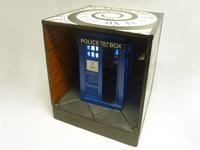
In the Doctor Who TV series, TARDIS is a time machine that looks likes a police box, and is bigger on the inside. A few months ago I saw a very cool implementation of this on Hackaday, and it was perfectly timed to remake one for Christmas.
Video
You can see the effect in the video below, before I give away how it's made.
If your browser does not support WebM for video, you can either watch on YouTube or download the video.
Design
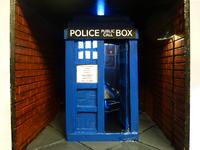

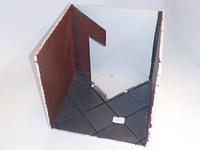
The design very closely follows Maladroit Modeller's version. Main trick is the diagonal mirrors, which reflect the side walls and the floor, making it appear like there is a similar wall behind the police box. Instead, the police box has no back wall, and the triangular space behind it has a few extra mirrors to further expand the space.
Biggest difference in my version is the extra diagonal mirror on the inside, which blocks direct reflection from the back wall towards the door. Otherwise when viewed straight on, the viewer would see their own image looking back at them, which quite much breaks the illusion. To limit the viewport, only the right side door opens in my version.

The mirrors are hidden by adding floor texture that has repeating tile edges at the places where the mirror edges also occur. It's not perfectly successful due to the thickness of the mirror, but works reasonably well.
Materials
The outside box and the TARDIS are made out of 3 mm thick PVC foam board. All the parts have been cut by hand with a hobby knife, and carved with various chisels and knifes.
The mirrors were cut from 1 mm thick acrylic mirror from a craft store. This proved much easier than trying to work with glass mirrors, as the cutout shape for the diagonal mirrors is a bit complex. A downside is that the plastic mirrors very easily got scratched during the build process, and I had to rub them with some polishing compound to hide the damage.
PVC foam board is nice to glue with superglue, as it forms very strong bonds. However, superglue tends to evaporate and fog up the mirrors, so I had to keep air circulating by blowing inside while the glue was curing.
Electronics
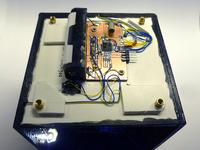
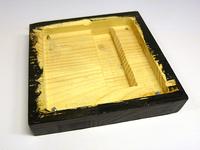
I installed a small motor to open and close the door, and several LEDs for light effects. Everything is driven by a STM32F030 microcontroller.
The PCB was also made manually with a hobby knife, it was simple enough as most parts can be connected directly to the microcontroller pins. There is a tilt switch to activate the device, and a H-bridge made out of IRF5851 logic-level MOSFETs.
There is also a sound effect of the TARDIS departure sound, and an occassional "exterminate, exterminate" of a Dalek attack. There is no separate speaker, the sounds are instead played back using the motor and the door as a speaker.
Everything is powered by a 3.6 volt rechargeable LiFePO4 battery. I originally planned to use a non-rechargeable LiSOCl2 battery, as they have a longer shelf life, but it didn't give enough current for the motor. The battery is easy to replace, though, as the wooden bottom goes on with just four screws.
Decoration
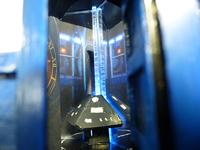
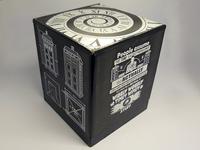
On the inside, I printed a background image of the walking bridge. My inkjet's ink somehow failed to dry on photo paper with an image this black, so I had to use regular paper which gave a bit dull colors.
The outside images have been printed with a laser printer, and attached with double-sided tape to the PVC.
Code
The code is available here on GitHub. It's a pretty simple bare-bones STM32F030 project, so maybe useful as a starting point or template for something else.
– Petteri Aimonen on 16.1.2019
